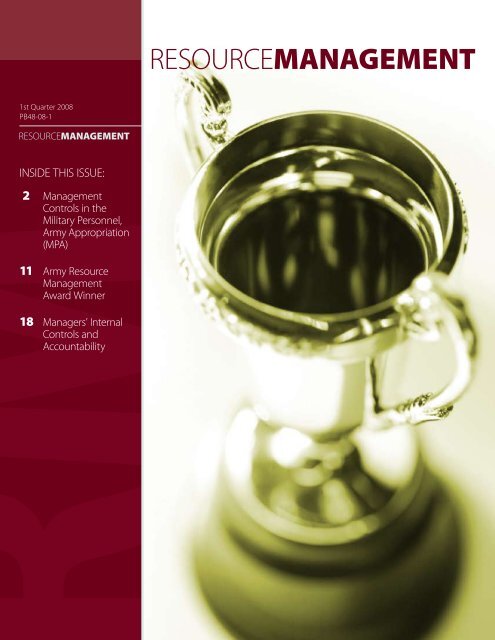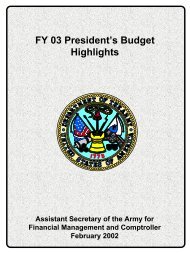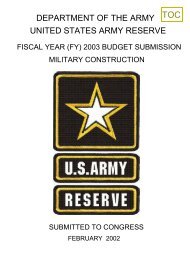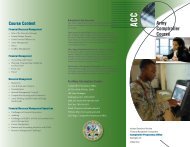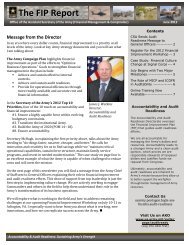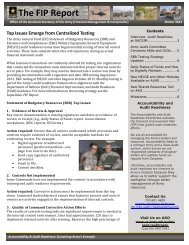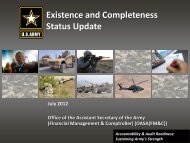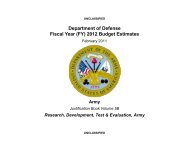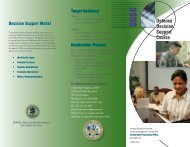inside this issue: - Army Financial Management - U.S. Army
inside this issue: - Army Financial Management - U.S. Army
inside this issue: - Army Financial Management - U.S. Army
Create successful ePaper yourself
Turn your PDF publications into a flip-book with our unique Google optimized e-Paper software.
1st Quarter 2008PB48-08-1<strong>inside</strong> <strong>this</strong> <strong>issue</strong>:2 <strong>Management</strong>Controls in theMilitary Personnel,<strong>Army</strong> Appropriation(MPA)11 <strong>Army</strong> Resource<strong>Management</strong>Award Winner18 Managers’ InternalControls andAccountability
This medium is approved for official disseminationof material designed to keep individuals within the<strong>Army</strong> knowledgeable of current and emergingdevelopments within their areas of expertisefor the purpose of professional development.1st Quarter 2008PB48-08-1By order of the Secretary of the <strong>Army</strong>:George W. Casey, Jr.General, United States <strong>Army</strong>Chief of StaffAdministrative Assistant tothe Secretary of the <strong>Army</strong>Joyce E. MorrowDistribution: SpecialAssistant Secretary of the <strong>Army</strong><strong>Financial</strong> <strong>Management</strong>and ComptrollerNelson M. FordManaging Editor, the PentagonPatricia M. HughesArt Director, U.S. GovernmentPrinting OfficeMarco J. Marchegiani2 2 2 2 2 2 2 2 2Resource <strong>Management</strong> is an official professionalBulletin published quarterly and sponsored bythe Assistant Secretary of the <strong>Army</strong> for <strong>Financial</strong><strong>Management</strong> and Comptroller. Unless otherwisenoted, material may be reprinted provided the authorand RM are credited. Views expressed herein arethose of the authors and not necessarily those of theDepartment of the <strong>Army</strong> or any element thereof. RMprovides a forum for expression of mature, professionalideas on the art and science of Resource management.It is designed as a practical vehicle for the continuingeducation and professional development of resourcemanagers through thought-provoking articles. Sendall correspondence to: Managing Editor, Resource<strong>Management</strong>, Comptroller Proponency Office, Officeof the Assistant Secretary of the <strong>Army</strong> (<strong>Financial</strong><strong>Management</strong> and Comptroller) ATTN: SAFM-PO,109 <strong>Army</strong> Pentagon, Washington, DC 20310-0109.Queries may be made by phone to DSN 222-7414or commercial (703) 692-7414. Please send a copyof each submission to Managing Editor, SAFM-PO,ASST SEC ARMY FIN MGT, 109 ARMYPENTAGON, Washington, DC 20310-0109.POSTMASTER: Please send address changes toManaging Editor, Resource <strong>Management</strong>, ComptrollerProponency Office, Office of the Assistant Secretaryof the <strong>Army</strong> (<strong>Financial</strong> <strong>Management</strong> and Comptroller)ATTN: SAFM-PO, 109 <strong>Army</strong> Pentagon,Washington, DC 20310-0109.<strong>inside</strong> <strong>this</strong> <strong>issue</strong>:2 <strong>Management</strong> Controls inthe Military Personnel,<strong>Army</strong> Appropriation (MPA)4 BC 36 Proponency Corner6 Resource <strong>Management</strong>Awards7 Hank Ofeciar AwardCeremony9 Speech from Classmate11 <strong>Army</strong> Resource<strong>Management</strong> Award WinnerFiscal Year 200716 Building Bridges tothe Future18 Managers’ Internal Controlsand Accountability20 Defense ComptrollershipProgram (DCP) – Chile Trip211181 s t Q u a r t e r 2008 1
R e s o u r c e M a n a g e m e n t<strong>Management</strong> Controls in the Military Personnel,<strong>Army</strong> Appropriation (MPA)By: Mr. Steven GrayThe Military Personnel, <strong>Army</strong> (MPA)appropriation is vital in providing forthe needs of the <strong>Army</strong>. It is the <strong>Army</strong>’slargest peacetime appropriation at $32billion; wartime funding adds another$12 billion. MPA funds sustain the All-Volunteer Force by providing ActiveComponent basic and special pays, retiredpay accrual, allowances for subsistence(rations) and housing, recruiting andretention incentives, permanent changeof station moves, death gratuity andunemployment compensation benefits,and Reserve Officers’ Training Corps(ROTC) and West Point cadet stipends.MPA funds also provide for ActiveComponent deployed pays as well asmobilized Reserve Component pay andallowances during wartime. Funds enablethe <strong>Army</strong> to meet manning goals by providingthe right number of high qualitysoldiers in the appropriate grades andskills to satisfy force structure requirementsand to fill combat formations.The MPA appropriation was thesubject of a very critical Department ofDefense (DoD) Inspector General auditreport released in September 2006. Thisreport found that the <strong>Army</strong> lacked effectiveprocesses and controls to effectivelymanage the appropriation and suggestedthat the <strong>Army</strong> may have already incurredan Anti-Deficiency Act (ADA) violation,(occurs when an entity uses appropriatedfunds for a purpose other than thatintended by the Congress, uses funds fromone fiscal year to cover bona fide needsof another fiscal year, or exceeds a formalsubdivision of funds). Although subsequentanalysis revealed that the <strong>Army</strong> hadnot incurred an ADA violation, the exposureremained. Something had to be doneto regain control.A number of challenges were readilyapparent. Constraints associated with2 1 s t Q u a r t e r 2008
R e s o u r c e M a n a g e m e n tinsufficient tools, processes, systems, andformal cost estimating procedures requiredconventional and unconventional thinkingto address the weakest links in the managementof the MPA appropriation. Keyinternal control improvements recentlyimplemented are addressed below.Problem 1: Pay and allowance obligationswere based on uneven monthly disbursementpatterns and not accrual data.(Some months only one payroll cycle disburses,some months two cycles disburse,and some months three cycles disbursedepending on the calendar.)The Solution: DoD FMR, Volume 3,Chapter 8, “Standards for Recordingand Reviewing Commitments andObligations,” requires that the militaryServices record obligations for amountspayable to military personnel in themonth earned. A methodology wasdevised to obligate a current month’s payand allowances based on the previousmonth’s accrual rather than obligatinga disbursement bridge. This seeminglyinnocuous process change greatlyimproved analysts’ ability to forecast payrollrequirements. In addition to changingthe payroll obligation process, analystsworked with DFAS to consolidate useof suspense accounts so that actual paydisbursements were no longer distorted bypay advances and collections.Problem 2: MPA appropriation stafffaced a fundamental lack of control overthe obligation of funds and funds distribution(due to system constraints, theMPA appropriation was forced to rely onDFAS-IN to perform these functions).The Solution: Analysts adapted a webbasedexecution system known as theResource <strong>Management</strong> Tool (RMT)for use in the MPA appropriation. Thisnew tool has enabled analysts to controlthe obligation of funds for the first timeever. RMT also put stringent funds controlmechanisms in place and providedenhanced visibility over disbursementdata. RMT has been adapted to uploadbulk subsistence requisition files fromthe Defense Logistics Agency (DLA) toensure obligations are properly recordedbefore disbursements post. Futureenhancements being worked includedevelopment of a system generated payrollMOD and better capability to manage the$300M Funded Reimbursable Account.Problem 3: The <strong>Army</strong> lacked controls toensure subsistence charges were appropriate.The Solution: Detailed analysis and closecoordination with DLA staff revealed thatthe MPA subsistence account was beingcharged for transportation of theater subsistence(these charges were embedded indetailed subsistence bills). Because transportationis more appropriately an OMAcost, analysts worked to discretely identifyfuture transportation charges by assigningunique theater DoDAACs and directingtransportation charges to the OMAappropriation. Analysts also cost transferredseveral hundred million dollars inprior charges to the OMA appropriation.Problem 4: Inability to view DJMS (paysystem) detail level transactions to developreliable cost estimates, validate accountingreports, and isolate Base from GWOTexecution for Cost of War Reporting.The Solution: Partnering with DASA(CE)and their supporting contractors, analystsdeveloped an Oracle query capability ofDJMS detail transactions for both activeand mobilized reserve components. Thisquery capability never existed before andhas greatly improved the quality and reliabilityof detailed MPA funding requests.It also helped detect at least 19 systemicerrors where detail pay transactions crossingfrom the pay system into the accountingsystem were posting in the wrongplaces. Over $80 million in disbursementtransactions have been transferred to theproper accounts. More recently, <strong>this</strong> querycapability served as the foundation for anew pay and allowances cost model . Thismodel will reduce time and effort requiredto generate MPA funding requests andwill improve accuracy. A cost model fornon-payroll items such as subsistence andOver $80 millionin disbursementtransactions havebeen transferred tothe proper accountspermanent change of station moves (PCS)is next on the agenda.Analysts charged with managing the MPAappropriation have made tremendousprogress in establishing and strengtheninginternal controls over the past 18 months.Additional internal controls are beingworked. For example, PCS is a key areawhere we have some concerns. SeveralLean Six Sigma efforts are underway tohelp bring <strong>this</strong> program under controlby the end of the FY. Throughout thesemajor transformation efforts, a key to successhas been the involvement of seniorleadership, who made efficient operationsa top priority and set measurable goalsfor individuals and staffs involved in <strong>this</strong>monumental undertaking. Another andperhaps more important key to success,has been having a dedicated and highlyskilled team in place to work these <strong>issue</strong>swith perseverance and tenacity, one biteat a time. Thanks to their efforts, most ofthe MPA appropriation is under positivefinancial control and financial risk to the<strong>Army</strong> has been greatly reduced.2 2 2 2 2 2 2 2 2About the Author:Mr. Steven Gray is a Senior ResourceAnalyst and Execution Lead for theMilitary Personnel, <strong>Army</strong> appropriationin the Office of the Assistant Secretaryof the <strong>Army</strong> (<strong>Financial</strong> <strong>Management</strong> andComptroller).1 s t Q u a r t e r 2008 3
R e s o u r c e M a n a g e m e n tBC 36 Proponency CornerBy General MelcherLieutenant General David F. Melcher, Military Deputyfor Budget, Assistant Secretary of the <strong>Army</strong> (<strong>Financial</strong><strong>Management</strong> and Comptroller)Major General Edgar E. Stanton III, Director of the<strong>Army</strong> Budget (<strong>Financial</strong> <strong>Management</strong> and Comptroller)This is the second article in a continuingseries about the transition to BranchCode 36 and new financial managementstructure, policies and practices.Just as the <strong>Army</strong> has revised financialmanagement doctrine, so have werevamped FM organization. At every levelwe have instituted changes, all of whichrevolve around integration of financialmanagement and resource managementinto a single structure, and making ourunits more deployable and more functionalin theater.After careful evaluation, <strong>Army</strong> financialmanagement reorganized into fourbasic elements: FM centers, G-8s at thedivision and corps levels, FM companiesand FM detachments. The FM centersreplace finance groups and finance commands,and are approximately half the sizeof these old organizations. They belongto the corps or the theater sustainmentcommand, and serve in a technical advisoryrole to other FM organizations andsustainment brigades. By the end of <strong>this</strong>year, there will be four active-componentfinancial management centers; already,one is operating in the Iraq theater.The role of the G-8 structure at thecorps and division level remains the same.However, in recognition of the need toaccount for taxpayers’ dollars in an areaof operations, and that <strong>this</strong> job cannot beaccomplished remotely from a CONUSinstallation, these positions have beenmoved from the Table of Distribution andAllowances to the Table of Organizationand Equipment. This critical changemakes G-8 personnel officially deployable,greatly enhancing financial managementin theater. As operations in Iraq andAfghanistan are reviewed, the G-8 structuremay be refined further, includingpossibly increasing the TOE.FM companies replace the formerfinance battalions. The most notable differencesin their composition as comparedto the old battalions are elimination ofthe battalion staff; and the addition of aresource management cell, which enablesthe company to perform accounting andcomptroller functions and to serve onjoint or command acquisition boards.FM detachments are directed by FMcompanies but provide financial managementsupport to brigade combat teamsand, as needed, other units and organizationsin the area of operations, includingthe division and corps. Their responsibilitiesinclude procurement support, disbursingoperations, non-U.S. pay supportand command, control and supervisionof financial management support teams,which likely will be widely dispersed.<strong>Financial</strong> management command andcontrol also has been revised. The oldfinance battalions reported directly tothe finance groups and commands. Thatrelationship no longer exists between thesuccessor organizations. Instead, financialmanagement companies are under thecommand and control of the sustainmentbrigade to which they are attached; FMcenters act as technical advisers to theFM companies. This revision to the chainof command better integrates financialmanagement activities into overall missionexecution and generally enhances the<strong>Army</strong>’s battlefield performance.The switch to these new organizationsand the new command structurewas predicated upon the fielding of certaintechnology. Yet, while the physicalconversion is largely complete, the modernizationof supporting systems is not– which leaves a transformed FM organizationoperating in a legacy environment.The <strong>Army</strong> had assumed that the DefenseIntegrated Military Human ResourcesSystem would be working by now and, asa result, we would be out of the militarypay business. Unfortunately, DIMHRS’arrival was delayed and <strong>Army</strong> financialmanagement has been required to retaina mission for which the new structurewas not designed.4 1 s t Q u a r t e r 2008
R e s o u r c e M a n a g e m e n tAs a result, all 90 of our financialmanagement detachments currently carrythree extra personnel to execute militarypay functions. The financial managementcommunity has been granted permissionto retain these additional Soldiers for upto one year after DIMHRS achieves initialoperating capability, after which timethose slots will be returned for allocationelsewhere. Currently, we anticipate thatDIMHRS will go live at the start of fiscalyear 2009, though it may not have all thecapability originally expected at that time.<strong>Financial</strong> management therefore is consideringnegotiating with <strong>Army</strong> headquartersto keep the extra 270 personnel beyondthe one-year post-IOC limit to ensure thatthere is no adverse impact to Soldiers’ pay.The new FM structure also wasbuilt with the General Fund EnterpriseBusiness System in mind. GFEBS is progressingwell and Increment 2 should befielded at Ft. Jackson <strong>this</strong> summer. Thislatest module will manage the <strong>Army</strong>’s $30billion real property and general equipmentportfolios and will support installationmanagement activities, includingfinancial processes for command and staff,personnel and community, informationtechnology, operations, logistics, engineering,resource management, acquisitionand health services. It also will supportfinancial activities at the Defense Financeand Accounting Service, and <strong>Army</strong>headquarters activities. Until GFEBS isimplemented <strong>Army</strong>-wide, though, we maynot fully realize all of the benefits of FMorganizational transformation.The integration of resource managementand finance operations into a singlediscipline is a significant milestone. Thisholistic approach will bring huge dividendsin efficacy and efficiency. Change is nevereasy; but, in <strong>this</strong> case, it is absolutely necessaryfor the <strong>Army</strong> to maintain its abilityto fight anywhere, anytime, and to conductThe integrationof resourcemanagementand financeoperations into asingle disciplineis a significantmilestonethe nation-building operations that seemlikely to be a mainstay of the 21 st century.I urge everyone to take the time toreview in depth our new doctrine andorganization. This discussion of FMtransformation will continue over thecoming months. As always, your thoughtsand comments are appreciated.1 s t Q u a r t e r 2008 5
R e s o u r c e M a n a g e m e n tResource <strong>Management</strong> AwardsDid you know that the <strong>Army</strong> <strong>Financial</strong>Community numbers over 16,500?Many of these civilian and military financialmanagement professionals are doinggreat things for the <strong>Army</strong>. The AmericanSociety of Military Comptrollers(ASMC) Professional DevelopmentInstitute (PDI) and the AssistantSecretary of the <strong>Army</strong>, <strong>Financial</strong><strong>Management</strong> and Comptroller (ASA,FM&C) will present several awards tocivilian careerists and military membersfor their outstanding performance duringfiscal year 2007 at <strong>this</strong> years <strong>Army</strong> Dayon May 28, 2008 in Orlando, Florida.In <strong>this</strong> <strong>issue</strong>, we are featuring theResource <strong>Management</strong> (RM) award winnersand a brief synopsis of their collectiveaccomplishments. There are a possiblesixty-one RM Awards in several categoriesavailable to reward the diligent resourcemanagers that help keep our <strong>Army</strong> strong.And yet, a total of only 100 nominationswere received for consideration. WithResource <strong>Management</strong> Awards CategoriesAccounting and FinanceAnalysis and EvaluationAuditingBudgeting Intern *Comptroller/Deputy Comptroller Educator **over 16,500 professionals in our careerfield, I know that there are many more<strong>Army</strong> resource managers doing phenomenalfeats, which directly and indirectly,benefit <strong>Army</strong> Soldiers and their Families.Surely, they are doing things such asreducing problem disbursements, improvingthe quality and timeliness of reportcontent, reducing paperwork, improvingfunds control, interfacing with other areasto ensure more efficient processes, anddeveloping new or substantially revisingand improving existing financial managementsystems. Their everyday effortsin their various resource managementpositions entail the accomplishmentslisted above and can be used to nominatethem and address the criteria required toreward and recognize them during the<strong>Army</strong> Day Awards ceremony.The Resource <strong>Management</strong> Awardspresented during <strong>Army</strong> Day are just oneway to recognize our careerists for theirexcellent performance in <strong>Army</strong> financialInnovative Use of TechnologyResource <strong>Management</strong>Cost Analysis RM Author **Cost Savings Initiatives Team ***Education, Training, and Career Development Organization ***<strong>Financial</strong> <strong>Management</strong> System Improvement Capstone ****Resource <strong>Management</strong> in an Acquisition EnvironmentEach individual category awards one civilian and one military member at both the <strong>Army</strong> Command or Higherand Below <strong>Army</strong> Command levels (12 categories X 2 levels X 2 recipients = 48 awards)* Intern awards 2 individuals in the CP 11 Intern Program at both the <strong>Army</strong> Command or Higher and Below<strong>Army</strong> Command levels (1 category X 2 levels X 1 recipient = 2 awards)** Educator and Author categories award one <strong>Army</strong> civilian and one military member at any level(2 categories X 1 level X 2 recipients = 4 awards)*** Team and Organization each award one team and one organization at both the <strong>Army</strong> Command or Higherand Below <strong>Army</strong> Command levels (2 categories X 2 levels X 1 recipient team = 4 awards)**** Capstone awards the “best of the best” one civilian and one military and one civilian <strong>Army</strong> employee forthe Functional Chief Representative Special Award (3 categories X 1 level X 1 recipient = 3 awards)Total of 61 Possible AwardsBy Terry PlacekShowing ourappreciation tothe careeristsencourages themto continue todo great thingsfor the <strong>Army</strong>management. Other available awards arethe ASMC Achievement Awards, UnderSecretary of Defense (Comptroller)<strong>Financial</strong> <strong>Management</strong> Awards, the NeilR. Ginnetti Award, and the LTG (Ret)Jerry L. Sinn Award. Nominations forRM awards, as well as other <strong>Financial</strong><strong>Management</strong> Awards are just a matter ofwriting about the significant events thatimprove financial management in yourwork environment every day.Careerists can be nominated by asupervisor, a manager, a co-worker, ormay even self-nominate. Teams andOrganization nominations must be submittedby the group’s manager, supervisor,or leader. The Comptroller ProponencyOffice will be presenting a workshop during<strong>Army</strong> Day 2008 titled “Rewarding<strong>Army</strong> <strong>Financial</strong> <strong>Management</strong> Excellence”.The workshop will go into the specifics ofthe various award programs that are available,the categories of awards, nominationprocedures, timelines, and guidancefor the various awards. We will provideexamples of well-written nominations, willdetail what the “judges” expect to see in anaward winner, will show statistics on thevarious awards, and will answer questionsthat you may have about the award processes.We hope to see you there.Rewarding <strong>Army</strong> <strong>Financial</strong> Excellenceis the right thing to do. Showing ourappreciation to the careerists encouragesthem to continue to do great things forthe <strong>Army</strong>. For just a little time and effortcareerists can be shown appreciation andknow how important they are to theirorganization and to the <strong>Army</strong>. The paybackon investment is truly worth it!6 1 s t Q u a r t e r 2008
R e s o u r c e M a n a g e m e n tLeft to Right: Major Roub, Major Neumann, Angali Medappa,Annette Barron, General Melcher, and Terry PlacekHank Ofeciar Award CeremonySpeech by General MelcherMajor Ofeciarrepresents the bestof the <strong>Army</strong>Thank you very much for inviting me tojoin you today.This is both a somber and a happyoccasion. We have come together tohonor a soldier who did everything hecould to serve his country, in the endgiving the most precious thing, his life,in pursuit of that ideal. It is hard toquantify or qualify appropriately thewillingness to put one’s life on the linefor what we term the “the greater good”or “the good of the nation”. The bestterm – though it seems inadequate – isselfless service. Hank Ofeciar wasn’t justcommitted to an external concept of selflessservice; selfless service was inherentto Hank’s internal intellectual and emotionalmakeup.Major Ofeciar represents the bestof the <strong>Army</strong>. He volunteered for themost dangerous assignments, includingtwo tours in the Balkans and a rotationin Afghanistan. The role he chose inAfghanistan was counselor to the policeand the <strong>Army</strong>, helping them learn howto serve their own people properly andproudly. And, while protecting his countryand enabling others to protect theirs,he never forgot his responsibility to, orlove for, his family, returning home justdays before his own death to comfort hismother at the passing of her sister.I am proud that the Whitman Schoolof <strong>Management</strong> has chosen to honorHank. In doing so, I hope that Syracusenot only preserves the memory of <strong>this</strong>outstanding man but also inspires others,both military and civilian, to live as he did-- with strong ideals, a positive bearingand an unswerving belief in, and practiceof, selfless service.continued on page 71 s t Q u a r t e r 2008 7
R e s o u r c e M a n a g e m e n tWe should alwaysbe proud to serveeven though therisks are great,especially intime of warcontinued from page 8Victor Castillo is an excellent inauguralrecipient of the Ofeciar award, for he toolives according to the principle of selflessservice – also because that simply is hisnature. He is happy, even thrilled, to helpanyone anytime. He will go out of his wayas a friend, and do so with pleasure. Thephrase “generous to a fault” should haveVictor’s picture attached to it.I understand that Victor’s classmateshave experienced <strong>this</strong> generosity andchosen him for <strong>this</strong> honor to show theirappreciation for all he has done. I hearthat Victor has taken on the role of nurseto sick classmates, translator for the tripto Chile, and senior adviser to anyonewith a question or concern. All of you inthe comptrollership program have learnedthat you can always count on Victor.Service to the nation is a higher calling.We should always be proud to serveeven though the risks are great, especiallyin time of war. In honoring a soldier whodied in Afghanistan and a civilian whoembodies the service ethos, we honor allthe others out there – both military andcivilian -- who serve every day, put theirlives on the line -- and sometimes losetheir lives in the process.Congratulations, Victor. I wish peaceand solace to Major Ofeciar’s familyand friends. And thanks again to theWhitman School for taking note of theextreme sacrifice of <strong>this</strong> wonderful soldierwho did all he could for the people andthe country he loved.Hank Ofeciar wife, Angali Medappa and General MelcherLeft to right: Maj. Neumann, Victor Castillo (award winner), and Dean Melvin T. Stith, Dean of the WhitmanSchool of Business, Syracuse University8 1 s t Q u a r t e r 2008
R e s o u r c e M a n a g e m e n tHe was here atSyracuse to givesomething ofhimself, and hisfriends will tell youthat he gave themeverything he couldPhoto by Major Kathleen NeumannSpeech from ClassmateI enlisted the assistance of the <strong>Army</strong>Comptrollership Program (ACP) Classof 2005 to help share Hank’s light withyou. Though knowing Hank and his networkingskills, he probably knew a few ofyou sitting in the audience today. When Icontacted my classmates many reminiscedof our class photographer, who alwayshad a camera in his hand or of a strongwilled Hank and his independent natureand ability to not focus on extrinsic validation.I would be remiss, if I neglectedHank’s dedication to those in need. Oneof our class members lost two familymembers while attending Syracuse. Hanktalked with him, and helped <strong>this</strong> individualthrough a very rough time. Hankexhibited strong leadership skills and avolunteering spirit. He answered his callto serve his country and volunteered tosupport operations. All of the responsesfrom my classmates had common themes,and our Class Leader LTC Gil Huronwho is currently serving in Bagdad withthe 3rd Infantry Division, covered themwell with the following excerpt. “HenryOfeciar, Hank to most of us, was simply aBy Major Kathleen Neumannbeautiful person. He was young at heart,spirited, giving, and loving. He was a playful,energetic person whose energy camefrom his desire to pursue his curiosities,and the opportunities of life itself.”Hank was very active. He had a lovefor dogs and animals, the outdoors, family,people in general, and an insatiablecuriosity and drive to explore any andeverything that was new to him. Insome ways, Hank pursued his daily lifeas though life was new to him, and asthough everything he encountered wassomething that he had yet to experience,and he refused to just let it pass him by.I have the first email I ever received fromHank…one that all of our class receivedbefore any of us had met that portraysthe basic giving and friendly side of him,in which he invited everyone to his housefor a BBQ prior to the start of our class.Of all the people in the Department ofDefense (DoD) section of the program,he was by far the one individual who trulyexperienced the diverse nature of theprogram. Many of his friends were outsidethe <strong>Army</strong> Comptrollers communityand were from many different countries.Hank was just eager to learn and eagerto engage people of diverse culture. Heimmersed himself in groups of peopleoutside the DoD community in an effortto experience something more than thatwhich he had already lived, and he wasclearly the most capable of adapting toand cultivating cultural diversity and theenrichments to be gained on a personallevel by doing so. Hank was clearly hereat Syracuse University to gain more thanjust the scholastic enhancement. He washere at Syracuse to grow. He was hereat Syracuse to give something of himself,and his friends will tell you that he gavethem everything he could. Hank’s friendsfrom Syracuse came from the UnitedStates, Thailand, India, and Romania,and they took back with them a pieceof Hank. Hank’s smile defined him, themanner in which he chose to live his life,and that which he was capable of givingback to you.I charge everyone to use Hank’s pentathlete focus with your remaining timeat Syracuse University and challengeeveryone to live your experience at SU tothe fullest.Additionally, on behalf of the ACPClass of 2005, I would like to offerthe greatest congratulations to VictorCastillo, who WELL represents the spiritof <strong>this</strong> Award.1 s t Q u a r t e r 2008 9
R e s o u r c e M a n a g e m e n t10 1 s t Q u a r t e r 2008
R e s o u r c e M a n a g e m e n t<strong>Army</strong> Resource <strong>Management</strong>Award Winners, Fiscal Year 2007Congratulations Winners!!!The Office of the Assistant Secretaryof the <strong>Army</strong> (OASA), <strong>Financial</strong><strong>Management</strong> and Comptroller (FM&C)sponsors the Resource <strong>Management</strong> (RM)Annual Awards Program to recognizeand encourage outstanding performanceof individuals, teams, and organizationsthat make significant contributions to theimprovement of resource management.Open to both military Soldiers and civilianemployees, the RM awards are an excellentopportunity for the Assistant Secretaryto recognize the “best of the best” in theresource management community.The reviewing panels met and theAssistant Secretary of the <strong>Army</strong> for<strong>Financial</strong> <strong>Management</strong> and Comptrollerapproved the selections for the FY 2007Resource <strong>Management</strong> (RM) Awards. Heis proud to award the following awards toeach deserving recipient:Assistant Secretary of the<strong>Army</strong> (Fm&C) Civilian AwardThe ASA (FM&C) Civilian Awardrecognizes the top civilian <strong>Army</strong> employeeserving in a leadership capacity whom theAssistant Secretary personally cites foroutstanding contributions to the field ofresource management. The ASA (FM&C)Civilian Award recipient is Mr. Henry B.Hunt, Senior Systems Accountant for theUnited States <strong>Army</strong> Special OperationsCommand (USASOC).Mr. Hunt led his team through developmentof plans for USASOC DataProcessing Installation (DPI) consolidation,the BRAC closure of USASOCaccounting support at DFAS Orlando,and subsequent move of all USASOCaccounting service to DFAS Rome. Hisclear guidance to the field precipitatedaccurate set up and ultimate assurancethat funding transactions for FY 2008By Cathy Rinkerwould flow appropriately in the newResource <strong>Management</strong> Tool (RMT)financial system and into the accountingsystems. Mr. Hunt assumed the leadershipposition of the Accounting andIntegration team, even while performinghis duties as Senior Systems Accountantwith the escalated pace and complexity ofpreparing to close out budget analysts andcomptrollers accounts USASOC-wide.Assistant Secretary of the<strong>Army</strong> (Fm&C) Military AwardThe ASA (FM&C) Military Awardrecognizes the top military Soldier servingin a leadership capacity whom theAssistant Secretary personally cites foroutstanding contributions to the fieldof resource management. The ASA(FM&C) Military Award recipient isMAJ Richard J. Hoerner, U.S. <strong>Army</strong>Central Command, Budget Analyst –Afghanistan/NATO for HQ, Third<strong>Army</strong>, G8-CONOPS.MAJ Hoerner ensured a smoothfinancial management transition inAfghanistan. His presence and ability toensure a smooth financial managementtransition was so highly regarded duringthe Relief In Place/Transfer of Authoritybetween Combined Forces Command-Afghanistan (CFC-A), 10th Mountain and82d Airborne Divisions that the CJTF-82Chief of Staff requested he remain in countryfor four to six months and assist theircommand with teaching, coaching andmentoring financial management functions.MAJ Hoerner’s oversight and guidanceassisted in recouping over $100 million.He closed year end with a 99.9% obligationrate. His role as the U.S. financial expertin regards to the NATO Maintenanceand Supply Agency (NAMSA) directlyimpacted funding and contract decisions atthe NATO, SHAPE and coalition forceslevel and reflects the responsibility andauthority---clearly above his pay grade---entrusted to him by his command.Functional ChiefRepresentative (Fcr)Special AwardThe FCR Special Award recognizessomeone serving in a leadership capacitywhom the FCR, personally cites foroutstanding contributions to the CP11Program. The FCR Special Awardrecipient is Mr. Aaron R. Polley, CareerProgram Manager in the ComptrollerProponency Office, Office of the AssistantSecretary of the <strong>Army</strong> (<strong>Financial</strong><strong>Management</strong> and Comptroller).Mr. Polley ensured <strong>Financial</strong><strong>Management</strong> (FM) education, training andprofessional development opportunitiesfor over 16,500 professionals <strong>Army</strong>-wide.He was instrumental in securing fundingfor the <strong>Army</strong>-wide professionals toattend short-term and long-term training.Careerists gained more direct accessand higher awareness of important careerdevelopment aspects through his briefingsat professional FM workshops andtraining events and vigilant maintenanceof Comptroller Proponency informationon the ASA (FM&C) Homepage. Heplanned and coordinated the <strong>Army</strong> DayEvent at numerous American Societyof Military Comptrollers ProfessionalDevelopment Institutes. Mr. Polley briefedOASA (FM&C) leadership on <strong>Army</strong> DayEvent details and formed and directed thePlanning Action Team Members that successfullyproduced the <strong>Army</strong> Day Events.Outstanding Resource<strong>Management</strong> OrganizationAward(Above <strong>Army</strong> Command)— Headquarters,Department of the <strong>Army</strong> (HQDA), ASA,FM&C, <strong>Army</strong> Budget Office, Operationsand Support Directorate, MilitaryPersonnel Division – During FY 2007 <strong>this</strong>team suggested and implemented severalinternal control improvements for theMilitary Personnel Appropriation (MPA).continued on page 121 s t Q u a r t e r 2008 11
R e s o u r c e M a n a g e m e n tcontinued from page 11They implemented a web-based system,Resource <strong>Management</strong> Tool, to control theobligation of funds. They devised a bettermethodology to obligate pay and allowancesmonthly. They developed an Oracle querycapability, which has improved the qualityand reliability of MPA funding requests forboth the active and reserve components.They devised a process to obligate subsistencetransactions prior to disbursementusing detailed order files while a new systemis being fielded to automate <strong>this</strong> process.They improved upon the methodologyused to report GWOT cost of war informationto OSD and the Congress. Thanksto the hard work, dedication and expertiseof these individuals, the MPA appropriationis back on the right track.Organization Members: James P.Fasano, Steven E. Gray, and Kimberly D.Hayes.(Below <strong>Army</strong> Command)— Installation<strong>Management</strong> Command (IMCOM) –Fort Drum, NY, Directorate of Resource<strong>Management</strong> – During FY 2007 the ingenuityand collaborative efforts of the entirestaff were instrumental in overhauling thedirectorate Status of Funds reporting process,which resulted in man-hour savingsof over 240 hours annually and reducedthe number of days to produce monthlystatus reports for installation directorates/activities. Their meticulous management ofthe Garrison’s Total Obligation Authorityof a quarter billion dollars afforded theSoldiers and Family members of the FortDrum community the required resourcesto support Readiness and Quality of Lifewhich significantly impacts on the All-Volunteer Force.Organization Members: Elsie M.Fitzsimmons, Roxane E. Melton, Anne M.Seegebarth, Richard H. Temple, Rosalie H.Austin, Kimberly M. Ormiston, BarbaraL. Pillans, Letetia A. Dahle, Patricia L.Marcello, Mark A. Hawes, Artema L.Wright, Walter G. Koepp, Diane D.McMullen, Leslie S. Alton, Carol K. Steria,Gilbert A. Allen, Pamela M. Nabewaniec,and Karin Fossett.Outstanding Resource<strong>Management</strong> Team Award(Above <strong>Army</strong> Command)— U.S. <strong>Army</strong>Central Command (USARCENT) andthe Resource <strong>Management</strong> office forIII Corps at Fort Stewart, GA – Teammembers expertly performed during theconversion of the <strong>Army</strong>’s total stock fundbudget to the Funds Control Module(FCM). This high performing team submitted190 problem reports and analyzed18 million conversion documents anddiscovered $94 million in erroneous obligations.Through identification of FCMerrors, and the resultant process improvementsuggestions to overcome FCMerrors and shortfalls, they saved the <strong>Army</strong>nearly a half-billion dollars. The team’sproven logistical and financial expertiseallowed it to clearly verbalize problemsand effects of problems. They presentedcogent solutions and guaranteed thatdeployed forces receive uninterrupted supportwithout feeling the effects of systemchange in FY 2007.Team Leader: Audrey MossTeam Members: Polly Williams, PatrickWarner, Daniel Buxton, CPT John Yun,SFC Bryan Harding, Michael Byrd, KathyHack, Linda Richardson, and Theo Mixon.(Below <strong>Army</strong> Command)— U.S. <strong>Army</strong>Developmental Test Command (CSTE-DTC-RP-H), Aberdeen Proving Ground,MD - The Unit Business EfficiencyResourcing (UBER) Team developed aprocess that ensures effective and efficientexecution of a $2 billion annual budgetacross nine geographically dispersed ranges,improves DTC’s ability to develop requirementsand defend resources, and ensurescompliance with the established law. Theyrevolutionized the key components of a“one of a kind” decision-making tool. Thetool allows what-if drills and identifiespotentially obsolete assets. This invaluabletool better articulates the resourcesrequired and helps to more accuratelyallocate available resources to supportthe overall <strong>Army</strong> transformation effortsand the Long War on Terrorism, whichwill enable the <strong>Army</strong> to deploy faster, hitharder, and exit the combat theater morerapidly with fewer losses. Through the indepthanalytical efforts and commitmentof the team, the U.S. <strong>Army</strong> DevelopmentalTest Command has developed and implementeda decision-making tool that providesthe right resources, at the right place,and at the right time.Team Leader: Diana SchoffstallTeam Members: JoAnn L. Ely, David W.Glenn, and Elizabeth C. Murter.Civilian Individual AwardsAccounting and Finance(Above <strong>Army</strong> Command)— Mr. HenryB. Hunt, U.S. <strong>Army</strong> Special OperationsCommand, Fort Bragg, NC – Mr. Huntshows true professionalism in his role asSenior Systems Accountant. His expertsystems accounting skills and knowledge,coupled with his stellar customer service,leadership, guidance and communicationsduring the entire year while leadingthe accounting team through developmentof plans for the USASOC DataProcessing Installation (DPI) consolidation,the BRAC closure of USASOCaccounting support at DFAS Orlandoand subsequent move of all USASOCaccounting service to DFAS Rome,resulted in a flawless transition to theDPI consolidation and the new accountingservice for USASOC.(Below <strong>Army</strong> Command)— Ms. CarolJ. Walker, U.S. <strong>Army</strong> Training andDoctrine Command (TRADOC),Combined Arms Center (CAC) G8,Fort Leavenworth, KS - Ms. Walker isthe Supervisory Budget Officer and isdescribed as the linchpin of the CAC.She is responsible for overall managementof CAC financial systems. She successfullytransitioned CAC from usingthe Database Commitment AccountingSystem to the Resource <strong>Management</strong>Tool. Ms. Walker also successfully managedimplementation of Wide Area WorkFlow. She is a great coach and mentor.Her professional demeanor, wise counsel,and technical expertise are central to theefforts of the CAC’s G8.12 1 s t Q u a r t e r 2008
R e s o u r c e M a n a g e m e n tAnalysis and Evaluation(Above <strong>Army</strong> Command)— Mr. Gary E.Ward, <strong>Army</strong> Materiel Command, FortBelvoir, VA - Mr. Ward is a SupervisoryBudget Analyst and directly responsiblefor the accomplishment of all program,planning, budgeting and executionrequirements for the <strong>Army</strong> WorkingCapital Fund (AWCF) IndustrialOperations (IO) program. He led severalefforts to implement changes in policyand processes in the WCF arena thatsignificantly enhanced the efficiency andeffectiveness of the products affected.He successfully spearheaded the effort tochange DOD FMR in order to increaseCIP threshold from $100 thousandto $250 thousand increasing installationcommander flexibility in use ofresources to meet customer productionrequirements. Mr. Ward is the “go-to”person and the technical expert for WCFIndustrial Operations.(Below <strong>Army</strong> Command)— Mr. Michael J.Nielsen, <strong>Army</strong> Materiel Command, FortMonmouth, NJ - Mr. Nielsen is a SeniorEvaluator and is assigned as lead evaluatoron high priority reviews---MilitaryInterdepartmental Purchase Requests(MIPRs) and the Government TravelCard. He brought new LEAN ideas tothe audit liaison process and made suggestionsfor streamlining and improving communicationsand relations. Mr. Nielsenidentified questionable transactions withthe Government Travel Card whichresulted in identifying about 200 incidentsof misuse. As a result of the MIPR review,he identified over $800 thousand thatwas deobligated. He has suggested thatthe ASA, FM&C establish an SOP tobe used for all personnel who work withMIPRs.Auditing(Above <strong>Army</strong> Command) – Mr. CharlesR. Brownfield, <strong>Army</strong> Audit Agency,St. Louis, MO - Mr. Brownfield is anAudit Manager, but was Acting ProgramDirector for most of FY 2007 andresponsible for the overall running of the<strong>Financial</strong> <strong>Management</strong> Audits Division inaddition to completing his own tasks. He<strong>issue</strong>d 12 draft reports which exceededmanagement expectations. Mr. Brownfieldheld meetings prior to audits with clientsand stakeholders which led to anoverall decrease in the number of auditordays required to complete projects. Hiseffectiveness and efficiency contributedto client satisfaction. He has receivedfavorable client satisfaction ratings. Mr.Brownfield promoted teamwork and wasvery involved as managing auditor. Underhis tutelage, Mr. Brownfield’s employeesfelt that they had opportunities to learn,grow, and improve their skills.Budgeting(Above <strong>Army</strong> Command) – Mr. Dale L.Hanson, Office of the Assistant Secretaryof the <strong>Army</strong> (<strong>Financial</strong> <strong>Management</strong> andComptroller), Investment Directorate -Mr. Hanson, as Chief of the MunitionsDivision, successfully defended andobtained $1.4 billion in FY 2007 supplementalfunds. He produces eight budgetsubmits (two for each appropriation:Ammunition, Missiles, Aircraft, andChemical Demilitarization). He successfullybriefed Armed ReconnaissanceHelicopter restructure and saved the<strong>Army</strong> over $200 million. Mr. Hanson iscalled upon frequently by Senior <strong>Army</strong>leaders because of his tremendous technicalknowledge and his ability to explainhugely complex <strong>issue</strong>s in layman’s terms.He is a trusted expert in the field of <strong>Army</strong>Munitions.(Below <strong>Army</strong> Command)— Ms. Ann E.Capps, U.S. <strong>Army</strong> Reserve Command(USARC), 89TH Regional ReadinessCommand (RRC), Wichita, KS - Ms.Capps is the resident Reserve PersonnelAppropriation expert at the 89th RRC.She is responsible for realizing a costreduction by promptly deobligating TDYorders and reducing aged accounts. Ms.Capps conducted five budget trainingclasses for key personnel. She continuouslycoaches and mentors budget analysts.Ms. Capps created an accurate andtimely fund manager report for informingfund managers of their financial status.She also developed a back-up programfor TDY orders on CDs greatly reducingthe amount of required filing cabinetspace. Ms. Capps has successfully completedall of her assigned tasks despiteincreased OPTEMPO. She openly sharesher knowledge, expertise, provides soundrecommendations, and is committed toalways providing the best possible support.Cost Savings Initiatives(Above <strong>Army</strong> Command) – Mr. ArthurW. Pulket, <strong>Army</strong> Reserve NationalGuard (ARNG) - Mr. Pulket, a Facility<strong>Management</strong> Engineer, encouraged andtrained the force to use Design Build asthe primary delivery means for the BRACProjects of the <strong>Army</strong> National Guard.This accelerated the design process andallowed projects to be brought into constructionphase much quicker. Mr. Pulketwas a member of the <strong>Army</strong> NationalGuard BRAC team which executed 100%of all projects assigned, the only componentof the <strong>Army</strong> or of any service to doso. They achieved a cost savings over $10.8million. Mr. Pulket assisted in accomplishingthe excellent BRAC team results inaddition to performing his normal duties.He is directly responsible for 23 projectsinvolving Katrina damage to ARNGinstallations totaling $750 million.(Below <strong>Army</strong> Command)— Mr. PaulS. O’Leary, Installation <strong>Management</strong>Command (IMCOM) Headquarters,U.S. <strong>Army</strong> Garrison – DAEGU - Mr.O’Leary is a <strong>Management</strong> Analyst whohas increased program productivity, efficiency,and provided notable cost savings/avoidance for the garrison. He facilitateda comprehensive update of facility occupancy,validating the square footage andusage of all customer units and activities.Through Mr. Leary’s efforts, the commandearned an additional $200 thousandin reimbursements in FY 2007 and forprojects an additional $300 thousandin FY 2008. Mr. Leary modified andimproved the support agreement document.His suggestions for improving thesupport agreement process <strong>Army</strong>-wide iscurrently under review at Headquarters,Department of the <strong>Army</strong> (HQDA).continued on page 141 s t Q u a r t e r 2008 13
R e s o u r c e M a n a g e m e n tBuilding Bridges to the FutureBy Ms. Jean WighamThere has been a great deal of talk inrecent years about the “aging” workforce and the need to create an environmentthat encourages talented and energeticpeople to enter the federal government,specifically the <strong>Army</strong>, as a careerchoice. One prominent way is through theCareer Intern program, which has beengiven a boost in the last couple of years byan injection of funds to increase the numberof interns. In additional to the internprograms, there are programs that mentorjunior career employees to “bridge thegap” and help them to become the leadersof tomorrow. For example the NationalSecurity Personnel System (NSPS) mayoffer the opportunity to attract talentedpeople at higher levels of experience basedon competitive salaries to both “bridge thegap” and provide leadership role models.16 1 s t Q u a r t e r 2008
R e s o u r c e M a n a g e m e n tNSPS is also redefining the role of thesupervisor to become more involved inpersonnel management.None of these programs will be successfulwithout direct involvement by currentsupervisors. Supervisors and managersshould ensure that employees who have thedrive and ambition are given the opportunitiesthey need to enhance their educationand get the training and job opportunitiesneeded to advance in their careers.One requirement of the Career InternProgram is that interns must have a trainingplan reviewed and approved by theircareer managers, but more frequently thanJob rotations,developmentalassignments,and overseasrotations are partof the growth anddevelopment oftomorrow’s leadersnot, once they have graduated from theintern program, these new careerists findthemselves with supervisors (military andcivilian) who do not take the time to helpdevelop training plans for further developmentand maturation. Local internsare sometimes given limited trainingopportunities due to a lack of funding.Many newly graduated interns get stuckin middle management levels because theyhaven’t been given training to expand theirskills. Frequently technical employees arerefused training opportunities because ofworkload priorities.While training plans are important,diversity in job assignments is essentialto ensure depth of experience andunderstanding. The <strong>Army</strong> does <strong>this</strong> withyoung soldiers to develop and expandtheir skills, why do we not encourage<strong>this</strong> for career civilians? Job rotations,developmental assignments, and overseasrotations are part of the growth anddevelopment of tomorrow’s leaders, yetwe seem to have a problem allowing ourtalented people to take advantage of theseopportunities. We do not encourage civiliansto seek new opportunities; in factwe discourage it because civilians providehistorical experience’. We are afraid tolose our ‘best and brightest’ and maysometimes fail to encourage participationfor those who may express an interest,or, seek to promote internally to keepthese resources. We fail to recognize thatbecause we have limited their experienceto a single organization, we have limitedtheir growth opportunities.NSPS will not solve these problems.Perhaps we do not take enough time totrain Supervisors to be Managers – asdefined by Webster -- from one who has“authority to hire, fire, discipline, and rateemployees” to “someone who handles orcontrols resources, especially one whodo so with skill”. Unless we change therole of a supervisor to that of a manager,we will be unable to “stopgap” betweenthe “aging workforce” and the leaders oftomorrow. In fact, we cannot grow leadersif we cannot overcome the inertia associatedwith supervision. We must be theLeaders of Today and recognize that weneed to encourage our best and brightestto develop training plans, take rotationalassignments or development positions,and sometimes leave the <strong>Army</strong> to gainskills in other agencies or services.Give our graduate interns, our skilledspecialists and talented employees thetools they need to become Leaders of theFuture. Help “bridge the gap” and ensurethat, when you leave, you have left a legacythat encourages growth in leadership.2 2 2 2 2 2 2 2 2About the Author:Ms. Jean Wigham began her career asa Manpower Intern at Fort Bragg, NC.She currently serves as the DeputyDivision Chief, Program DevelopmentDivision, PAED. Ms. Wigham has over34 years of experience at the installation,MACOM, and HQDA levels in thefields of manpower management, budgeting,and programming.1 s t Q u a r t e r 2008 17
R e s o u r c e M a n a g e m e n tManagers’ Internal Controlsand AccountabilityIn preparing to write <strong>this</strong> article, I spentsome time thinking about the concept ofinternal controls, sometimes referred toas management controls in terms of organizationalrequirements, and the relationshipor similarities to everyday life.Business organizations are actually quitesimilar to families or social groups levels ofdocumentation and formality (controls) inthe these groups vary and in some instancesare non-existent. These differences mayBy Mr. Jorge F. Rocavery well have a direct influence to the successor failure of the organizational (Familyor Business) goals and/or objectives.Take for instance thefollowing scenarios –My youngest son’s Boy Scout troopwas preparing to go on an overnightcamping trip. As part of the preparationprocess they had a variety of classes, toinclude going over a camping packinglist. Some of the Scouts asked why theyneeded a packing list. The Troop leaderexplained that a good Scout is alwaysprepared and a packing list is a good wayto ensure that nothing that will be neededduring their camp out is forgotten.One summer weekend, I made plansto go fishing with a buddy of mine. Inorder to make sure that I did not forgetanything, I made a list of everything Iwanted to take with me the night before.When we arrived at the lake and got readyto cast our lines, my friend came over tome and asked me if I had some extra baitthat he could use, admitting that he hadforgotten to pack his.While I was in the <strong>Army</strong>, during oneof many field-training events, we commonlyused the buddy system whenpreparing for a tactical road march. Onefunction of <strong>this</strong> system required us to performpre-combat checks. This allowed usto make sure we had not forgotten to tapedown metal parts in our equipment (noisediscipline), that we had all the equipmentwe needed and that everything was ingood working order. When we were done,the platoon sergeant pulled out a couple oflaminated cards that contained a checklistof items we needed for the mission, safetybriefing and risk assessment. I asked theplatoon sergeant why he used the cards.I had worked with him for a while and Ihad never known him to forget anything,in fact everyone in the battalion consideredhim to be the best at what he did.His response was that no one is perfectand at any given time we are bound toforget something, and by using his checklist (leader cards) he was sure to not forgetand make sure that everyone was ready forthe mission.Over time I have seen many instanceswhere organizational objectives were notmet, financial reports were misstated,or injury or loss of life occurred becausesomeone did not have appropriate controlmeasures to mitigate risks. In fact I haveencountered many people that believeinternal controls are only a financial managementrequirement.However, Managers’ Internal Controls18 1 s t Q u a r t e r 2008
R e s o u r c e M a n a g e m e n tare not limited to financial management.Internal controls include other businessprocesses. Internal controls over our businessprocesses help us ensure that specificoutcomes are derived based on adherence tospecific guidelines established by the organization,laws and/or regulations. SeniorLeaders’ risks assessment and establishmentof internal controls for high risk areas isa key to mitigating and reducing negativeoutcomes resulting from weaknesses ininternal controls. Periodic reviews and testingof established internal controls help toidentify weaknesses or necessary changesas a result of changes in laws, regulations,automation technology, organizational mission,strategic objectives, and other changesin the operating environment.Below are a list of documents thatprovides guidance to managers in establishinginternal controls:The <strong>Army</strong>’s Managers’ InternalControl Program operates under the directionof the Federal Managers’ <strong>Financial</strong>Integrity Act (FMFIA) of 1982 whichestablishes specific requirements withregard to management controls. Theagency head must establish controls thatreasonably ensure that (i) obligationsand costs comply with applicable law, (ii)assets are safeguarded against waste, loss,unauthorized use or misappropriation, and(iii) revenues and expenditures are properlyrecorded and accounted for. The Actencompasses program, operational, andadministrative areas as well as accountingand financial management.OMB Circular A-123 – Defines management’sresponsibility for internal controlin Federal agencies. A re-examinationof the existing internal control requirementsfor Federal agencies was initiated inlight of the new internal control requirementsfor publicly-traded companiescontained in the Sarbanes-Oxley Act of2002. Circular A-123 and the statute itimplements, the FMFIA, are at the centerof the existing Federal requirements toimprove internal controls.OMB Circular A-123 Appendix A – Thecircular provides updated internal controlstandards and new specific requirementsfor conducting management’s assessmentof the effectiveness of internal control overfinancial reporting (ICOFR).<strong>Management</strong> is responsible for establishingand maintaining internal controlto achieve the objectives of effective andefficient operations, reliable financialreporting, and compliance with applicablelaws and regulations. Internalcontrol, in the broadest sense, includesthe plan of organization, methods andprocedures adopted by management tomeet its goals.<strong>Management</strong> is responsible for developingand maintaining internal controlactivities that comply with the followingstandards to meet the objectives:• Control Environment• Risk Assessment• Control Activities• Information and Communications,and Monitoring<strong>Management</strong> should identify internaland external risks that may prevent theorganization from meeting its objectives.When identifying risks, managementshould take into account relevant interactionswithin the organization as well aswith outside organizations. Identifiedrisks should be analyzed for their potentialeffect or impact on the agency. Beloware some key “Risk” definitions.Risk: The uncertainty of an event occurringthat could have an impact on theachievement of objectives.Risk assessment: A systemic process forassessing and integrating professionaljudgment about probable adverse conditionsand/or events.Risk management: The culture, processesand structures that are directed towardsthe effective management of potentialopportunities and adverse effects.Senior Military and Civilian Leadersand Managers are responsible andaccountable for establishing viable, effectiveand efficient internal controls thatprovide reasonable assurance to mitigatethe following risk factors:<strong>Management</strong>should identifyinternal andexternal risks thatmay preventthe organizationfrom meetingits objectives• Fraud, waste, abuse, ormismanagement of governmentresources• Effect on combat readinessor program accomplishment• Illegal acts• Political sensitivity or media interest• Effect on safety, health,security or morale• Systemic weaknesses—mightresult in recurring problems• Minor deficiencies that becomesignificant in the aggregate• Previously identifiedproblems not being correctedThe <strong>Army</strong>’s Managers’ InternalControl Program formally began in 1983,and in the 24 reporting years since inception,the <strong>Army</strong> has reported 233 MaterialWeaknesses to the Department ofDefense, of which only four remain openas of the end of fiscal year 2007. This isan annual average of 9.7 resolved materialweaknesses resulting in organizationaloperational improvements.Although, managers are responsible andaccountable for internal control programs,the effectiveness and ultimate success ofthe managers’ internal control programsdepend on everyone in the organization.2 2 2 2 2 2 2 2 2About the Author:Mr. Jorge F. Roca is the Director, <strong>Management</strong>Services Directorate, in the Officeof the Deputy Assistant Secretary ofthe <strong>Army</strong> (<strong>Financial</strong> Operations)1 s t Q u a r t e r 2008 19
R e s o u r c e M a n a g e m e n tDCP students visiting the Anglo American DivisionLos Bronces in the Andes mountain Range, the secondlargest mining company in Chile.Defense Comptrollership Program –Chile TripOn December 15 – 24, a group ofSyracuse University students and stafftraveled to Chile to experience the businessculture and learn about businessprocesses in Latin America. The tripwas organized by the Austral Group andincluded tours of several cities, speakersfrom numerous entrepreneur and economicorganizations, tours of businessesin Chile’s biggest industries, a servicelearning project in the community, and atrip to the Andes Mountains.Chile is recognized as having a growingand open economy. Chile has enjoyed anaverage annual growth rate of 5.6% since1990 and maintains the highest GDP inLatin America. In addition, Chile was thefirst country to sign free trade agreementsBy Brian Blank and Denise Oberndorfwith the United States, the EuropeanUnion and China. Chile, Argentina,and Brazil serve as the backbone of theMercosur free trade block, with key rolesin the integration and development ofSouth American economies. Chile’s amazingdevelopment over the last 17 yearshas earned them a business transparencyranking on par with those in the developedworld.The Whitman School of Business studentsand staff maintained a full schedulethroughout the trip. The group includedeight Defense Comptrollership Program(DCP) students (Kirsten Abare, MAJEric Anderson, CPT Kristi Andrews,Brian Blank, Victor Castillo, CPTJayme Hansen, Denise Oberndorf, andCheryl Partee), seven MBA students andAssociate Dean Shula. All went on guidedtours of Santiago and Valparaiso, notingChile’s “Wall Street” and various state,defense, judicial, and historic buildings.The students attended presentations byAMCHAM, Endeavor Chile and Lloyd’sRegister on foreign investment, entrepreneurshipin Latin America, and qualityassurance and ISO standards in Chile,respectively. In addition, they also visitedCavas del Maipo (local winery), FarmaciasAhumada (Latin America’s largest pharmacychain), Kross Brewery, and AngloAmerican Division Los Bronces (coppermine) to learn of business tactics for entryinto foreign markets, supply chain management,discussion on growth, strategyand defining new markets for consumerproducts, and copper market managementand labor <strong>issue</strong>s.Like most countries, Chile also haspublic programs to provide care forabused or neglected children. Thus, to getthe full experience and to give back to thecommunity, Whitman students and staffparticipated in a service learning projectat VE Global. The students painted twobuildings that were being refurbished tohouse abused children. The students didbreak from working to sing Christmassongs and dance with the children.While the trip included lots of learningopportunities, it was not all work.The group managed to squeeze in somerest and relaxation with a trip to theAndes Mountains and a visit to theLodge Andino El Ingenio. A great timewas had by all.2 2 2 2 2 2 2 2 2The DCP represents a cooperativeendeavor between Syracuse Universityand the Department of Defense, withstudents completing a Masters in BusinessAdministration and Executive Master ofPublic Administration. The program isunder the direction of Col.(R) David Berg.20 1 s t Q u a r t e r 2008
February 25 – March 20, 2008(by row from left to right)Back Row: Malanio Lipscombe, Morito Hamamoto, Luvenia Baker, Mary Louise Brumley, Robert Davis, Connie McAuliffe, Susan Trucks,Zuleika Brooks, Matthew Spencer, *Raymond Van Zante, Hyongkwon Pak, Tom WilsonFront Row: Leah Ford, Jacqueline Schmunk, Rosa Rodriguez, Marion Teal, Tom Schweer, Cynthia Boone, *Malai Tubtim, Jeannice Malave* Deborah Winder not available for picture**Class Liaison


